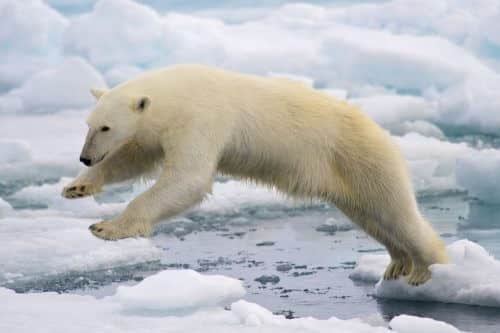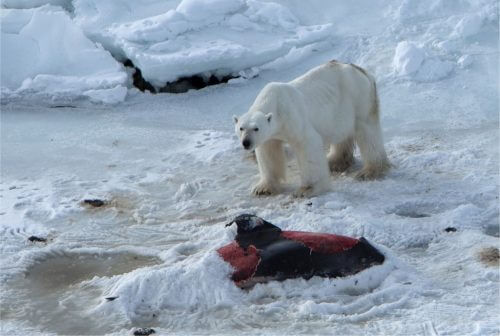Climate change makes it harder for polar bears to hunt seals, their favorite food, but brings a new dish to their menu: dolphins

By Mia Falah, Angle, Science and Environment News Agency
The polar bear has long become the most recognizable symbol of the fight against climate change. One of the most influential and watched nature films, "Planet Earth" ends with an unforgettable scene of an exhausted polar bear swimming dozens of kilometers between melting ice blocks and unable to find land or a floating block of ice big enough to support its weight.
That polar bear apparently drowned a long time ago trying to find a stable place to rest and hunt, but his living brothers are still struggling with the effects of climate change in their habitats. In recent decades, the accelerated melting of the glaciers and the shrinking of the ice surfaces in the North Pole make it difficult for nature's largest predator to find its natural food - seals. Therefore, the bears are forced to look for other sources of food, and sometimes even go ashore and eat berries, sea birds, eggs and even moose, sheep and rodents. Now, researchers in the Norwegian Svalbard reserve in the North Pole Document it Bears were observed eating dolphin meat, a species that had not been observed in the area until then.
Opportunistic hunters
The phenomenon was documented in the early spring of 2014, in an incident where an adult polar bear was observed eating two white-beaked dolphins. Dolphins of this type usually arrive in the Arctic region during the summer, at a time when the ice has already melted and the bears cannot reach them and hunt them in open water. This time, the dolphins arrived a few months earlier and thus allowed the bears to hunt them. In the month of April there are still ice storms in the Pole, and apparently such a storm caused the dolphins to be trapped inside the ice areas, unable to go back to the open sea. Apparently, the bears took advantage of the opportunities when the dolphins came up to breathe air and managed to hunt them. As they sometimes do with other whales.

But what made the dolphins change their behavior and arrive in the area earlier than usual? This is probably due to the fact that the water in the area was warmer than usual. Although the distribution of dolphins of this type is in relatively cold water areas, they do not like the icy winter temperatures of the Pole and, as mentioned, reach it only during the summer - when the water temperature rises and food is more available. However, the climate change that causes to the warming of the ocean water, resulted in the dolphins reaching the area early and then getting stuck in it due to strong winds that piled up ice inside the fjord and froze it. Later that year, the researchers recorded five more cases in which different polar bears preyed on dolphins, apparently members of the same group that was trapped in the ice pack.
The more fat - the better
The polar bear is the heaviest predator nowadays - an adult male can weigh up to 900 kilograms - this is because the bears develop a thick layer of fat that allows them to survive in the freezing cold of the pole. In order to build this insulated layer, the polar bear usually relies on hunting seals living in the area, whose bodies are also very rich in fat and are adapted to the freezing temperatures of the Arctic waters and the ice surfaces floating on its waters. With The acceleration in the melting of the glaciers and the shrinking of the ice surfaces In the North Pole, due to climate change, the hunting areas of the bears are also shrinking, as they find it difficult to hunt the seals in open water areas. Researches show that they move to rely more and more on other food sources, which are not necessarily enough to build the thick layer of fat they need to survive the freezing winter.
The dolphin predation recorded by the researchers may be a one-off case, which occurred due to several different coincidences in a particular year, but as the sea continues to warm and the glaciers continue to disappear, it is likely that there is evidence of such events that destabilize the ecosystem - of other carnivorous animals that are not their usual prey - will only continue to accumulate in the coming years.
The animals are forced to try to adapt to the changes and eat everything they manage to hunt in their race for survival. The question is what will happen next, when the effects of climate change will mean that there will no longer be new solutions for hunting. Will there be winners in this survival race?

2 תגובות
The menu of polar bears is enriched by polar tourists. According to the bears, the tourists are much juicier than the current batch of polar explorers, who tend to be fibrous and mushy. The tourists also bring aromas of foreign countries and the aroma of money.
Just as in ice and interglacial periods in the past the animals had to adapt - the same will happen this time - the polar bear will probably disappear from the world - but it must be remembered that this is the way of nature on earth.
There are studies that indicate that the frequent climate changes in East Africa (from where, according to genetic research, our origin) in the last 100,000 years constituted an evolutionary catalyst that resulted in our cognitive development as Homo sapiens